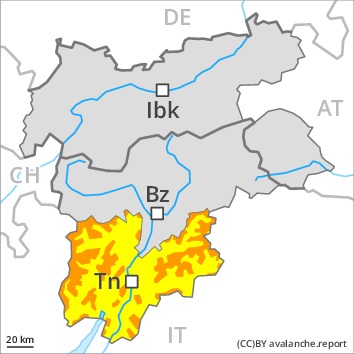
Danger level
 | 1600m
|
Avalanche Problem
 | | Persistent weak layer |
|  | |  |
 | | Persistent weak layer |
|  | |  |

Weak layers in the upper part of the snowpack necessitate caution.
Dry avalanches can as before be released, even by small loads in isolated cases and reach large size. Small and medium-sized natural avalanches are, however, not entirely ruled out. The avalanche prone locations are to be found in particular adjacent to ridgelines and in gullies and bowls, caution is to be exercised on steep slopes also below the tree line, as well as at the base of rock walls and behind abrupt changes in the terrain.
Whumpfing sounds and the formation of shooting cracks when stepping on the snowpack are a clear indication of a weakly bonded snowpack. Remotely triggered avalanches are possible. In addition a latent danger of gliding avalanches exists. In the event of solar radiation this applies in particular on steep sunny slopes.
Ski touring and snowshoe hiking call for extensive experience in the assessment of avalanche danger and careful route selection.
Snowpack
Towards its surface, the snowpack is fairly homogeneous; its surface consists of loosely bonded snow. In some places new snow and wind slabs are lying on surface hoar. The avalanche prone locations are sometimes covered with new snow and are therefore difficult to recognise. The new snow and wind slabs of last week are bonding only slowly with the old snowpack in all aspects.
Faceted weak layers exist in the centre of the snowpack in particular on shady slopes. Towards its base, the snowpack is well consolidated.
Tendency
At elevated altitudes a precarious avalanche situation will still be encountered. As a consequence of low temperatures the snowpack can not consolidate.







